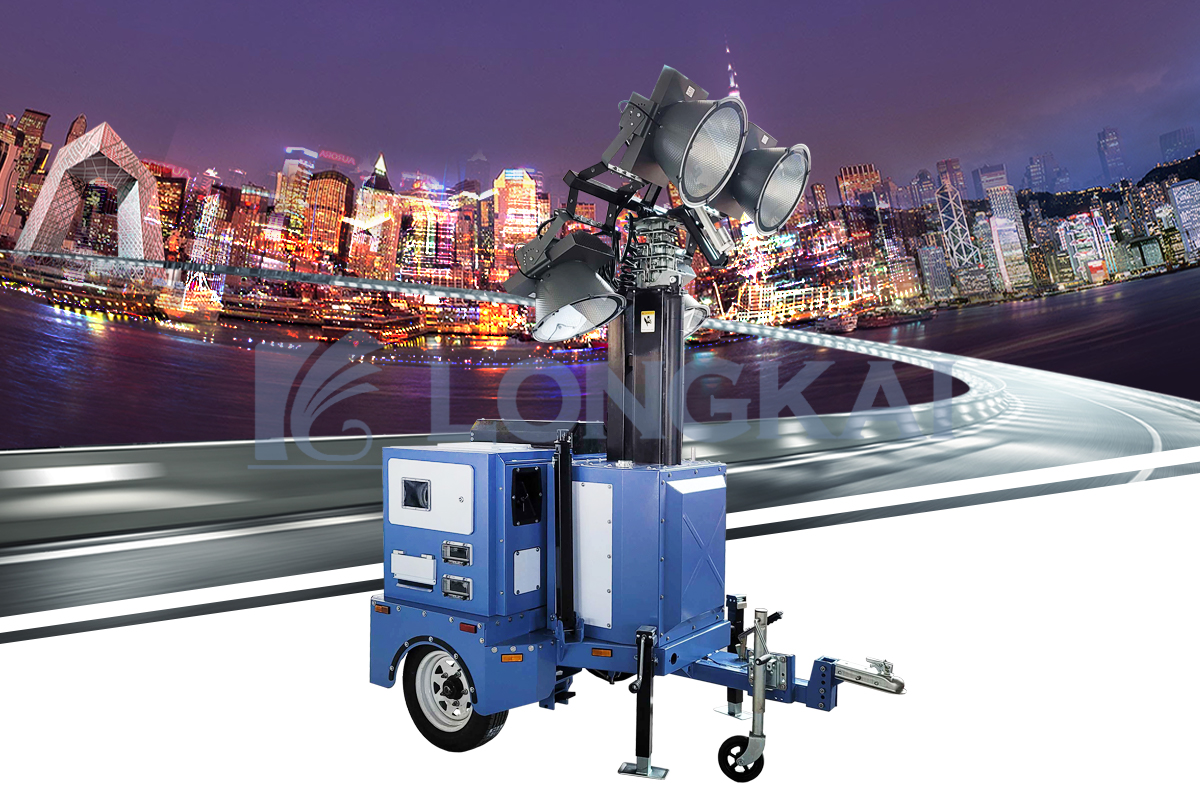Portable light towers are essential on construction sites, road projects, emergency response jobs, mining operations, and large outdoor events. One of the most common questions project managers ask is:
“How much fuel does a diesel light tower use each day?”
Understanding daily diesel consumption is critical for budgeting, scheduling refueling cycles, and choosing the most cost-effective tower for your job.
This comprehensive guide explains exactly how much fuel diesel light towers use each day, what affects consumption, how different models perform, and how diesel compares to electric, battery, hybrid, and solar alternatives.
What Is a Diesel Light Tower and How Does It Work?

A diesel light tower is a portable lighting system built for jobsites that need strong, reliable illumination. You’ll often see it at construction zones, roadwork areas, events, or emergency scenes. It stands on a towable trailer, so crews can move it fast. Once positioned, it raises a tall mast fitted with powerful lamps—usually LED or, in older models, metal halide. Then the diesel engine kicks in to generate electricity for the lights.
Key Components of a Diesel Light Tower
A diesel tower looks simple from the outside, but underneath, it’s a compact power system. Here’s what makes it work:
Diesel Engine + Generator – The engine spins the generator to produce electricity. It’s the heart of the unit.
Lighting Fixtures – Modern towers use LED lamps because they burn less fuel than metal halide.
Adjustable Mast – Reaches 7–9 meters depending on the model. It lets the lights cover more area.
Fuel Tank – Larger tanks allow long runtime. Many LED diesel towers can run over 150 hours before refilling.
Towable Trailer Base – Crews hitch it to trucks and move it anywhere.
These parts work together so operators can deploy bright lighting even where there’s no grid power.
How a Diesel Light Tower Produces Light
The process is straightforward:
You refuel the tank.
The engine starts.
It drives the generator.
Electricity flows into the lamps.
The lights illuminate the work area.
LED towers use this energy far more efficiently. Many consume less than 1 liter of fuel per hour, while metal halide systems burn 1.5–5 liters per hour.
LED vs. Metal Halide Inside Diesel Light Towers
Most modern diesel towers now run LED lamps because they save fuel and extend runtime.
| Feature | LED Diesel Tower | Metal Halide Diesel Tower |
| Fuel Use (L/hr) | ~0.55–1.0 | 1.5–5.0 |
| Warm-Up Time | Instant | Several minutes |
| Runtime | Up to 200+ hours | 60–100 hours |
| Efficiency | High | Low |
| Maintenance | Minimal | Frequent bulb/ballast checks |
LED technology helps reduce operating costs dramatically, especially on long projects.
Why Diesel Remains Popular on Jobsites
Even as battery and solar towers grow in demand, diesel units stay popular because:
They offer long continuous runtime.
They perform reliably in remote or harsh areas.
They provide high lumen output for large spaces.
They need no external power source.
Teams rely on diesel towers when bright, uninterrupted lighting is critical—especially during 24/7 operations.
How Much Fuel Does a Diesel Light Tower Use Each Day?
Fuel use varies a lot from one diesel light tower to another, but the pattern is easy to understand once you look at the engine, lamp type, and runtime. Most towers burn fuel steadily through the day because the generator must power the lamps nonstop. LED models sip fuel slowly. Metal-halide models use much more because their bulbs draw heavy wattage. Many crews check hourly consumption first, then multiply it by their shift length.
Average Hourly Fuel Consumption
Diesel light towers fall into two main groups:
Older towers run metal halide lamps, so they burn more fuel. Newer LED towers stretch every liter. Some LED models run more than 200 hours per tank because they use very little power.
Daily Fuel Use for Common Work Schedules
Here’s a simple view of how much fuel a typical tower uses in one day:
| Daily Runtime | LED Tower (≈0.7 L/hr) | Metal Halide Tower (≈2.5 L/hr) |
| 8 hours | ~5.6 liters | ~20 liters |
| 12 hours | ~8.4 liters | ~30 liters |
| 24 hours | ~16.8 liters | ~60 liters |
These numbers shift slightly depending on the generator size, lamp efficiency, and weather. Many heavy-duty towers consume even more when they run high-wattage lamps or power extra tools.
Real Examples from Popular Diesel Light Towers
Manufacturers publish runtime and tank capacity for their towers. That makes it easy to estimate how much fuel a unit burns each day.
Atlas Copco HiLight V5+ runs about 150 hours on 105 liters, which works out to roughly 0.70 L/hr.
Generac MLT6SMD stretches a 163-liter tank to 215 hours, or around 0.76 L/hr.
Traditional metal-halide towers often hit 3–5 L/hr, especially older 12,000-watt units.
A metal-halide tower operating all day can burn 70–120+ liters. An LED tower, on the other hand, uses a fraction of that.
What Affects Daily Fuel Consumption?
Daily fuel usage comes from a mix of design choices and site conditions. Several factors change how fast the generator burns fuel:
Lamp technology – LEDs reduce demand massively.
Engine condition – Clean filters, good oil, and quality diesel help it burn efficiently.
Temperature and altitude – Engines work harder in extreme climates.
Light settings – Full brightness uses more energy than dimmed output.
Extra electrical load – Workers sometimes plug tools into the tower’s outlets.
Most jobsites prefer LED towers now because they cut daily fuel use and reduce refueling stops.
Quick Visual: Daily Fuel Use Comparison
LED Tower (0.7 L/hr) → 6–17 liters/day
Metal Halide (2.5+ L/hr) → 20–120 liters/day
High-Watt Models → can exceed 100 liters/day
Diesel vs Battery vs Solar vs Hybrid Daily Fuel Use
Diesel Light Towers
Battery Light Towers (No Fuel Required)
From article.txt:
Solar Light Towers (Zero Fuel Cost)
From article.txt:
Hybrid Light Towers
➡ Hybrid is the best choice when lowering fuel usage is a top priority without sacrificing runtime.
How to Calculate Daily Fuel Cost for Diesel Light Towers
Here’s a simple formula:
Daily Fuel Cost = (Fuel Consumption per Hour × Hours Used per Day × Diesel Price)
Example:
LED tower at 0.7 L/hr running 12 hours/day with diesel at $1.20/L:
0.7 × 12 × $1.20 = $10.08 per day
Metal halide tower at 3 L/hr under same conditions:
3 × 12 × $1.20 = $43.20 per day
➡ LED towers can save $30+ per day in operating cost.
How Long Can a Diesel Light Tower Run Before Refueling?
Based on article.txt:
LED Diesel Light Towers
Metal Halide Diesel Towers
High-Output Diesel Towers
Longer runtime = fewer refuels, lower labor cost, and higher uptime.
Is Diesel the Most Cost-Effective Daily Option?
Advantages
Disadvantages
When Diesel is Best
How to Reduce Daily Diesel Consumption
Cutting daily diesel use isn’t hard once you understand how a tower burns fuel. Most diesel light towers waste fuel because the lamps draw too much power, the engine runs under poor conditions, or the tower stays on longer than needed. Small changes make a big difference, especially on long projects where fuel bills grow fast.
Switch to LED Lighting
LED lamps slash fuel use immediately. They pull far less power than metal-halide bulbs, so the generator doesn’t struggle as much. Many LED towers run more than 150–200 hours per tank because of their efficiency. A metal-halide tower may burn 3–5 liters each hour, but an LED unit often uses only 0.55–1.0 liters.
Here’s a quick comparison:
| Feature | LED Tower | Metal Halide Tower |
| Fuel Burn | Very low | High |
| Runtime | Longer per tank | Shorter |
| Cost Savings | Significant | Minimal |
| Warm-Up | Instant | Slow |
LEDs give crews brighter, cleaner light while saving fuel all day.
Maintain the Engine Regularly
A poorly maintained engine eats fuel quickly. Dirty air filters, old oil, or weak injectors force the generator to run harder. It burns extra diesel just to keep the lights stable. A simple maintenance checklist helps:
Clean air filters more often
Use quality diesel
Replace oil on schedule
Check belts and coolant
Inspect lines for leaks
A clean, well-serviced engine runs smoother, and it shows in the fuel numbers.
Adjust Light Output and Placement
The tower doesn’t need full brightness every minute. Many LED units allow dimming or selective control. Crews turn off one or two lamps when lighting a smaller area. Proper placement also matters. One tower positioned well can replace two poorly placed units.
Tips that help:
Raise the mast fully for wider coverage
Angle lamps to remove dark spots
Avoid pointing light into unused areas
Smart placement reduces the need for extra towers and lowers fuel use.
Use Timers, Sensors, or Automation
A lot of fuel disappears when towers run unattended. Timers fix this by switching lights on and off automatically. Some models include dusk-to-dawn sensors. Others offer smart controls that let teams adjust brightness remotely.
You can set the tower to:
Reduce Extra Electrical Loads
Some crews plug tools or chargers into the tower. It’s convenient, but it raises generator load. Extra load means extra fuel burn. If possible, move non-essential devices to a separate power source.
Small adjustments like these protect both runtime and the fuel budget.
Choose Hybrid or Solar-Assist Models When Possible
Hybrid towers combine diesel plus a battery pack. The battery carries most of the load, so the engine runs less. Some models run up to 360 hours in hybrid mode because the diesel engine only kicks in when the battery needs charging. Solar-assist systems help too. They let sunlight top up the battery, lowering diesel use even further.
Hybrid Tower Fuel Use → 30–60% lower than diesel-only units
Solar-Assist Tower → zero fuel during sunny days
LED Diesel Tower → lowest fuel use among diesel-only models
If your site wants long runtime and lower operating costs, hybrid systems give you both.
FAQ: Daily Fuel Use for Diesel Light Towers
Q: How much diesel does a light tower use per hour?
Most LED towers use 0.5–1 L/hr; metal halide towers use 1.5–5 L/hr.
Q: How much fuel does a diesel light tower use each day?
Between 15 and 120 liters, depending on lamp type, settings, and runtime.
Q: Are LED diesel towers cheaper to run?
Yes—LED towers use up to 70% less fuel.
Q: How long do diesel light towers run on a full tank?
Anywhere from 60–215 hours depending on model.
Q: Are hybrid light towers worth it?
Yes—hybrid models can reduce fuel usage by 60% or more, with fewer refuels.
Conclusion – Understanding Daily Diesel Usage Helps You Control Costs
Diesel light towers remain the most powerful and reliable choice for high-demand job sites, often consuming:
Selecting the right type of tower—and the right lamp technology—can significantly reduce fuel consumption and operating costs. For many applications, LED, hybrid, or solar-assisted systems offer major savings while maintaining high illumination levels.











